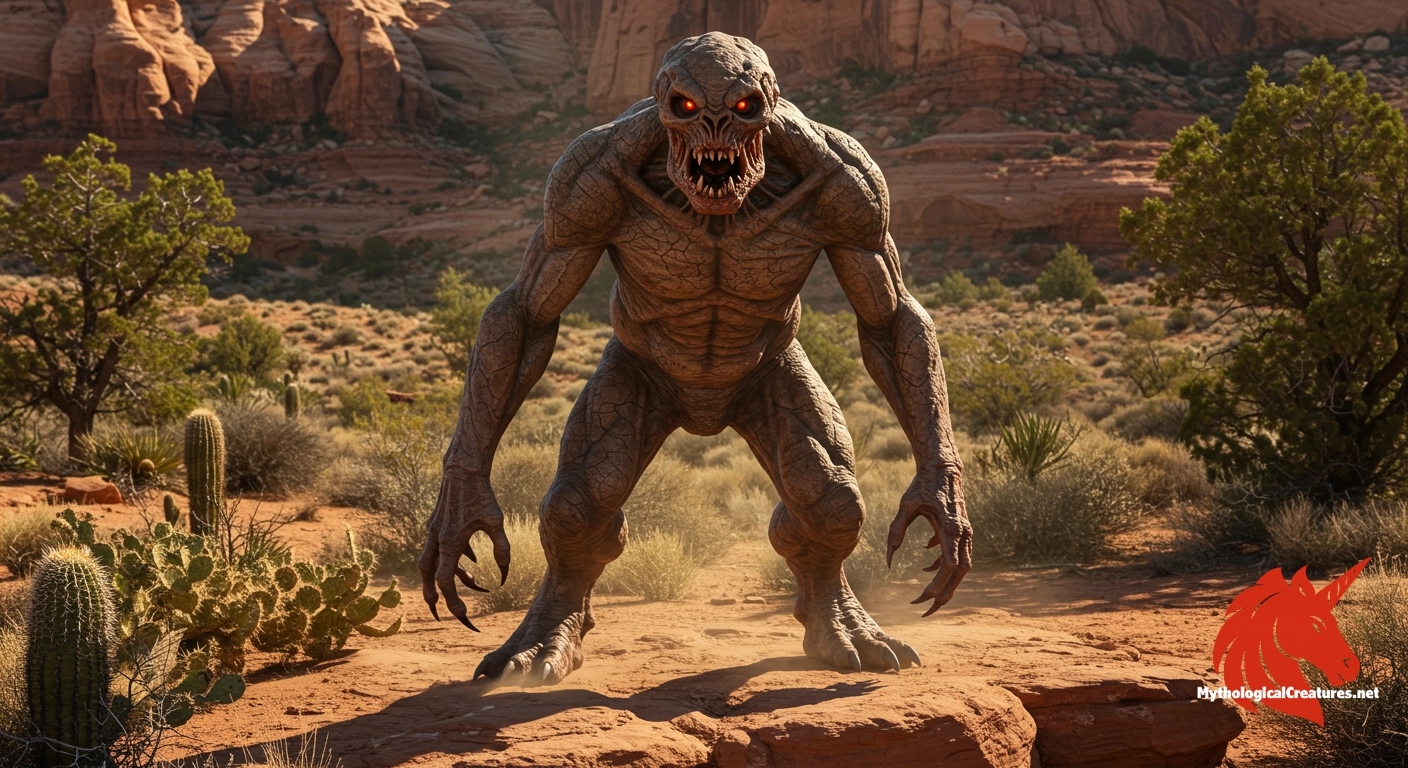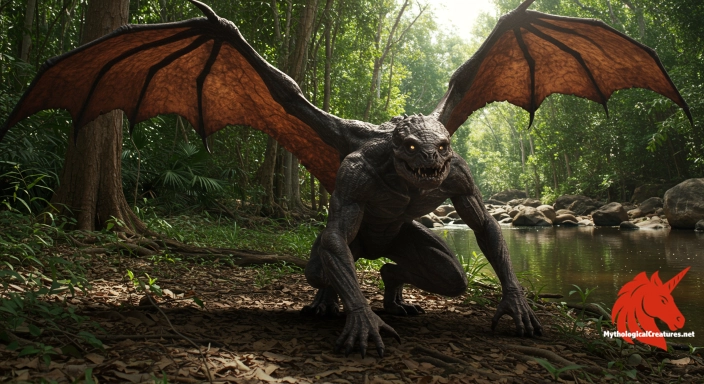Átahsaia: Átahsaia is a giant cannibalistic demon from Zuni mythology, renowned for its fearsome size and malevolent nature.

Átahsaia
Átahsaia - Serves as a fearsome embodiment of cannibalistic malevolence and a warning against moral decay within the cultural narrative of the Zuni.
Origins & First Encounters
Átahsaia emerges from the depths of Zuni myth as a looming giant whose cannibalistic nature and demonic attributes set him apart in indigenous cosmology. His origins lie in the rich oral traditions of the Zuni people, where he has been recounted through generations as a cautionary figure embodying transgression and uncontrollable wilderness. The demon is portrayed as a formidable force that challenges the harmonious order of the community and nature. His first attestation is believed to have been through ritualistic storytelling among the Zuni, wherein his monstrous deeds were both feared and respected. The lore surrounding Átahsaia encapsulates the deep connection that the Zuni have with the land and the respect for the untameable forces of nature. His presence serves as a reminder of the dangers that lurk beyond the known boundaries and the consequences of moral decay. Over time, his legend has been interwoven with themes of retribution and the complexities of human behaviour. The myth exemplifies how indigenous narratives utilise supernatural entities to impart ethical lessons and maintain social cohesion. His tale represents an intricate tapestry of cultural memory and serves as a mirror reflecting the community's own fears and values. The enduring narrative of Átahsaia reinforces a timeless dialogue between humanity and the mysterious forces of the natural world.
Source Texts & Tale Variants
The stories of Átahsaia have been primarily preserved through the rich oral traditions of the Zuni community, passed down by elders who hold the lore in high esteem. Early anthropological observations, while modest in documentation, provide glimpses into the demon’s role within ritual and taboo narratives. Multiple accounts offer variant portrayals, each coloured by the storyteller’s own experience and community context. Some tell of his fearsome presence as a solitary terror that stalks the desolate landscapes, while others embed him within a larger pantheon of destructive supernatural beings. Variations of the story have surfaced in ritual chants, cave paintings, and ceremonial performances, each contributing unique details to his mythos. The demon is often depicted in folklore as an omnipresent force whose appetite for human flesh symbolises the dangers inherent in straying from communal norms. Over generations, the versions have evolved, sometimes softening or intensifying his attributes to align with shifting cultural circumstances. Such narrative diversity not only highlights the fluidity of oral tradition but also underscores the complex role that such an entity plays in social instruction. As these stories have been recited in private gatherings and public ceremonies alike, they have taken on layers of meaning and reinterpretation. The interplay between fixed legend and creative variation has kept the lore of Átahsaia both dynamic and deeply rooted in Zuni identity.
Form & Powers
Átahsaia is typically envisioned as a being of enormous stature, a giant whose physical presence is as intimidating as it is enigmatic. His form is often described as a terrifying synthesis of human and beast, where exaggerated features merge to create a visage of pure horror. The demon is said to possess a rugged, wrinkled skin that appears battle-worn and marred with the scars of countless encounters. His eyes are imagined as fiery orbs that burn with a malevolent intensity, capable of instilling profound terror in any observer. In many depictions, a gaping maw filled with razor-sharp teeth is a central characteristic, emphasising his cannibalistic tendencies. His limbs are robust and powerful, suggesting a strength that surpasses that of ordinary mortals, with elongated claws that add to his predatory look. Some traditional portrayals incorporate elements such as twisted horns or spiked formations along his body, each detail enhancing his demonic authority. The overall physical representation combines the grotesque and the majestic, reflecting an entity that is both a literal and symbolic behemoth. His size and features vary in different narratives, yet the consensus remains that his appearance is engineered to inspire both dread and awe. Through these visual cues, Átahsaia manifests as a complex symbol of nature’s fury and the transgressive aspects of the human condition.
Regional Faces
While Átahsaia is firmly rooted in the Zuni tradition, his essence has been subject to regional reinterpretation across the Southwestern United States. Neighbouring Indigenous groups sometimes depict similar demonic figures, each adapting the core attributes to reflect their own cultural and environmental contexts. In some regional variants, the demon is portrayed with nuances that emphasise his connection to the harsh desert landscape and its unforgiving nature. Others infuse the character with a dual role, where he not only embodies destructive power but also serves as a warning against the abandonment of tradition. Local adaptations have even seen him interact with other supernatural beings, creating a layered pantheon that echoes local ecological and social challenges. Storytellers in various communities may alter details such as the demon's appearance or his method of devouring victims, each alteration serving a specific moral or practical teaching. The changes underscore the flexibility of indigenous myth, where the core symbolism remains intact regardless of narrative variance. Even in the face of modern influences, these regional iterations maintain the essence of a creature born from nature’s chaos and human hubris. Such diversity in depiction highlights the interplay between local identity and the universal themes detailed in his myth. Ultimately, Átahsaia stands as a testament to the adaptive and integrative nature of oral traditions across cultural boundaries.
Cultural Parallels
Comparative mythology reveals that the themes embodied by Átahsaia resonate widely across various cultural landscapes. His cannibalistic and monstrous attributes echo the narrative of the Wendigo found in Algonquian lore, where a similarly insatiable hunger represents the breakdown of natural and social order. In both traditions, the monstrous creature serves as a cautionary emblem of excess and moral decay. Other cultures have also introduced giant, fearsome entities whose very form is designed to challenge the societal constructs of good versus evil. While the Wendigo and other demonic figures such as the ogres of European folklore differ in contextual detail, they all embody the human fear of the uncontrollable and the taboo. The similarities extend to the symbolic functions of these legends, which often serve to delineate the boundaries between the known world and the chaotic, dangerous other. Such cross-cultural connections illustrate that the fear of cannibalistic, giant beings is not confined to one tradition but is a near-universal motif among indigenous peoples. By drawing parallels with other mythic monsters, one observes a shared narrative strategy intended to promote communal vigilance and moral discipline. Although each portrayal carries culturally specific elements, the universal undertones of transgression and destructive power remain remarkably consistent. These comparative insights offer a broader understanding of how myth shapes human perceptions of the monstrous and the unknown.
Legacy & Modern Evolution
The evolution of Átahsaia’s myth has been as dynamic as the oral traditions from which it sprang, undergoing reinterpretation and reinvention over the centuries. Initially a figure of raw, terrifying force in Zuni storytelling, his character has gradually been reinterpreted through the lens of modern artistic expression. Contemporary narratives tend to blend his classical attributes with contemporary themes, such as the consequences of ecological imbalance or cultural erosion. Modern reinterpretations have found a place for him in various media, including literature, visual arts, and even performance, where he serves as a symbolic bridge between ancient warning tales and modern societal concerns. The demon has also become a focal point for discussions on indigenous identity, reflecting both historical trauma and resilience. In some modern retellings, he is transformed into a complex character whose monstrous nature is juxtaposed with underlying themes of survival and retribution. Critics note that this evolution mirrors the changing dynamics of community fears and the reinterpretation of old stories to address new challenges. Present-day representations of Átahsaia often evoke a sense of nostalgia for the ancient past while encouraging critical reflection on modern life. His enduring legacy is a testament to the resilience of indigenous mythology and its capacity to adapt and remain relevant. As traditional lore meets the digital age, Átahsaia continues to serve as an emblem of the tensions between tradition and modernity, chaos and order.
Interesting Fact
An intriguing aspect of Átahsaia is that, while many mythological demons appear only as ethereal spirits, this entity is uniquely described as a gigantic, corporeal being whose terrifying physical presence underscores its role as a cannibalistic predator.
Quick Creature Info
Origin:
Features:
Our Mythic Legendary Rating:

Also Sometimes Known As:
Habitat:
Supernatural Powers:
Physical Attributes:
Abilities:
Behavior:
Lore:
Related Creatures, Tales or Lore
References
Discover Another Mythical Legend You May Not Have Heard Of?
Uncover the mysteries of ancient folklore and expand your knowledge of legendary beings from cultures around the world.
Dare to Meet the Garkain....
Curated by the Mythological Creatures Team (rev. May 2025)
